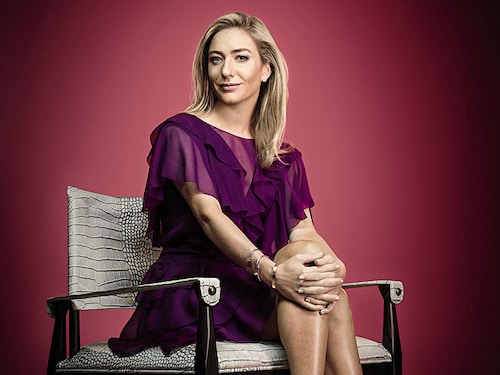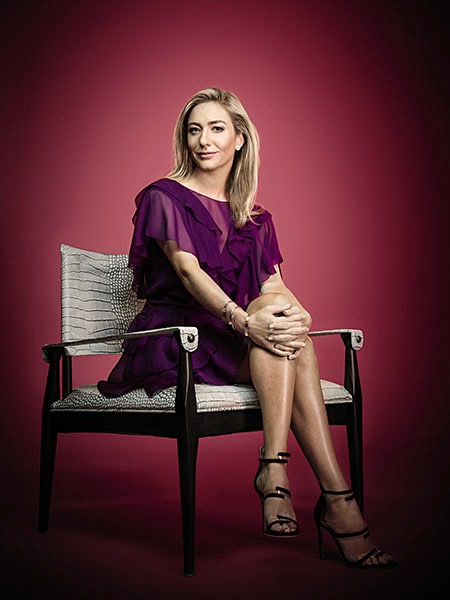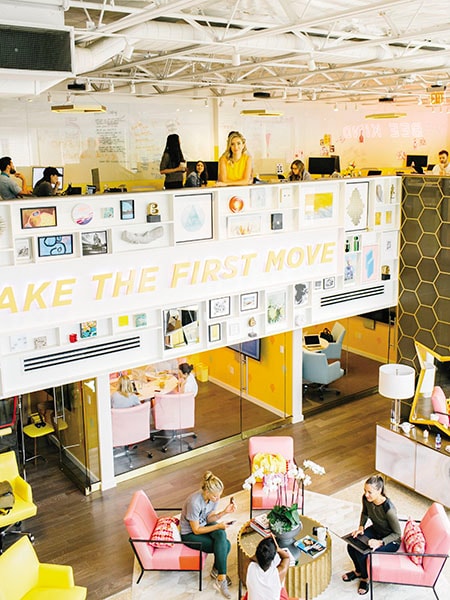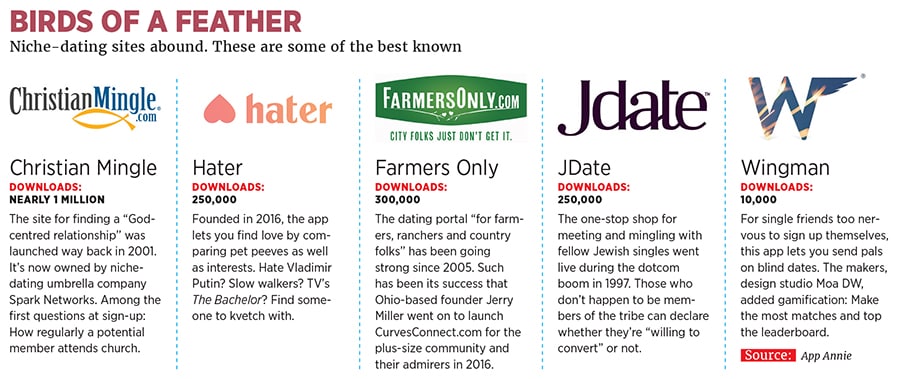Billion-dollar Bumble
Three years after leaving Tinder amid a nasty dispute, 30 Under 30 honouree Whitney Wolfe Herd is beating her old colleagues at their own game, offering women a dating app that's designed for them—and


 Image: Jamel Toppin for ForbesWhen Whitney Wolfe Herd started planning an October launch party for a new product at Bumble, America’s fastest-growing dating-app company, she was deliberate in her choice of venue: The Manhattan space that for 57 years hosted the Four Seasons restaurant, where regulars like Henry Kissinger, Vernon Jordan, Edgar Bronfman and Stephen Schwarzman created the ultimate power lunch.
Image: Jamel Toppin for ForbesWhen Whitney Wolfe Herd started planning an October launch party for a new product at Bumble, America’s fastest-growing dating-app company, she was deliberate in her choice of venue: The Manhattan space that for 57 years hosted the Four Seasons restaurant, where regulars like Henry Kissinger, Vernon Jordan, Edgar Bronfman and Stephen Schwarzman created the ultimate power lunch.
The space now has a new name, new management and a new menu. And, as Herd insists, a new perspective on business. “The power lunch is no longer just for men,” Herd announces to the mostly young, mostly female crowd, before ceding the stage to the pop star Fergie. “We all deserve a seat at the table.”
That table surely now includes the 28-year-old Herd, who has changed the tenor of dating dynamics. By letting women make the first move, Bumble has amassed over 22 million registered users, to Tinder’s 46 million, and at more than 70 percent year-over-year growth, to Tinder’s roughly 10 percent, it’s closing the gap quickly. Bumble began monetising via in-app purchases only in August 2016 and will cross $100 million in sales this year, a figure that—aided by the introduction of tailored, hyperlocal advertising—is projected to double in 2018. Herd turned down a $450 million buyout offer from the Match Group earlier this year, according to sources with knowledge of the conversations. And these sources maintain that Match approached the company again this fall to discuss a valuation well over $1 billion. This 30 Under 30 honouree retains 20 percent of Bumble, a stake that makes her a centimillionaire. (Match declined to comment.)
It’s a stunning comeback. As co-founder and vice president of marketing at Tinder, which has reinvented how people date and mate, she was part of one of the great business success stories of the smartphone age. But then she found herself in one of the era’s great public dramas. In June 2014, she sued Tinder for sexual harassment, alleging that her ex-boss and ex-boyfriend Justin Mateen called her a “whore” and “gold digger” and bombarded her with threatening and derogatory text messages, which she attached to her complaint. She also alleged that Tinder, owned by IAC and then by its Match Group spinoff, had wrongly stripped her of a co-founder title. The company denied any wrongdoing, but Mateen was suspended and then resigned. Sean Rad, then the CEO of Tinder, told Forbes in 2014 that Herd bore part of the blame for the bad blood between her and Mateen. The suit was quickly settled for a sum that Forbes previously reported to be approximatel`y $1 million. (The settlement bars the parties from discussing the case.)
There’s no question who the founder of Bumble is. Rather than sulk about Tinder, Herd decided to compete against it. In doing so, she belatedly entered one of the most crowded and established digital fields (over 90 percent of online dating startups fail) and nonetheless quickly carved out a lucrative space by focusing on the needs of one segment: Women. More than 10 percent of Bumble’s users pay $9.99 for a monthly subscription to access perks like extra time to decide whether a suitor merits a message. At Tinder, just about 5 percent of users pay for a similar service, according to a report from the investment firm Jefferies. It helps, of course, that her segment also happens to represent a majority of the population.  CEO Herd wants Bumble to empower women in dating, friendship and career“I just don’t harbour resentment toward anything or anywhere or anyone—I’m too busy,” Herd says. But if success is the best revenge, then nine digits in three years flat offers the kind of vindication people make movies about.
CEO Herd wants Bumble to empower women in dating, friendship and career“I just don’t harbour resentment toward anything or anywhere or anyone—I’m too busy,” Herd says. But if success is the best revenge, then nine digits in three years flat offers the kind of vindication people make movies about.
Herd’s path to Bumble was unintended. In the months between filing suit against Tinder and settling, she experienced the sort of online abuse that’s all too familiar to women who make public sexual harassment allegations. “I was being told the ugliest things by complete strangers, and they were having full debates about me,” Herd says. “I wasn’t running for office. I wasn’t trying to be on a reality show. I was just a girl who left somewhere.”
When that abuse turned into rape and murder threats from strangers, she deleted her Twitter account. Panic attacks and paranoia followed. A Salt Lake City native who attended private school and is a third-generation legacy at Southern Methodist University in Dallas, she retreated to Texas and the family of her then boyfriend Michael Herd, who’s now her husband. “I was broken,” she says. Trying to give some purpose to this trauma, Herd began sketching out a women-only social network called Merci, which would focus on positivity. “No compliments on physicality,” she says. “Compliments about who they are.”
Then came an unsolicited email from someone with an unfamiliar address and a Russian name, Andrey Andreev. Born in Moscow and based in London, Andreev in 2006 had founded Badoo, an online dating network that is today the world’s largest, with over 360 million registered users in 190 countries. Herd had met Andreev at a dinner in 2013 while she was at Tinder, and she’d made an impression. “To be honest, I immediately fell in love with Whitney’s passion and energy,” says the thick-accented Andreev, who has acquired a reputation as a recluse because he rarely grants interviews. “I thought she was a very cool lady and that I should be watching her very carefully.”
When she didn’t reply, his team emailed Herd’s lawyers, wishing her well with her legal battle and adding that he’d like to work with her. “My original idea was to get her as CMO at Badoo,” says Andreev, who’s 43.As it turned out, Herd had plans to visit her little sister at cooking school in Paris, and she made a pit stop in London. She didn’t want any part of his job offer. “Dream on—I’m not for hire,” she recalls saying. “I’m starting a company, and I don’t want to be in dating.” She did pitch him on Merci, though. While Andreev liked the idea of a women-centric social brand, he thought Herd should stick to her forte and his: The dating sector. They spent days walking around London’s streets and parks together, exchanging ideas. Andreev told her he wanted to pair her innate talent for marketing and branding with the infrastructure, capital and resources at his disposal after almost a decade at Badoo.
After she settled the Tinder lawsuit in September 2014—which, conveniently, did not contain a non-compete clause—she took Andreev up on his offer. He’d make an initial investment of about $10 million for launch marketing and commit additional funds to fuel growth, taking 79 percent of the company. She’d be the founder, the CEO and a 20 percent owner, with all the autonomy those titles imply, while tapping into Badoo’s infrastructure and Andreev’s know-how. Both have come in handy. At Badoo, Andreev has a decade’s worth of A-B tests, data on the effectiveness of various monetisation efforts and experience of bringing a product to scale that have no parallel in the dating market. When the time came to start charging users for in-app perks, for instance, the team at Bumble was able to develop sophisticated technology to support subscriptions from day one thanks to input from Badoo.
From September to December of that year, Herd flew between Texas and London around 15 times. She and Andreev brought in two of her fellow former Tinder executives, Chris Gulczynski and Sarah Mick, to design the new app’s back end and user interface. (The two left Bumble in April to launch their own agency but still share the 1 percent of equity not held by Andreev and Herd.)
undefinedBumble feels more polite and walled off, avoiding the unsolicited photos that plague online dating[/bq]
One night, over cocktails, Herd stumbled upon Bumble’s special sauce. “I always wanted to have a scenario where the guy didn’t have my number but I had his,” she recalls telling Andreev. “What if women make the first move, send the first message? And if they don’t, the match disappears after 24 hours, like in Cinderella, the pumpkin and the carriage? It’d be symbolic of a Sadie Hawkins dance—going after it, girls ask first. What if we could hardwire that into a product?” It was the kind of brilliant tweak that comes from someone who understands the target demographic because they’re in it. After toying with names, the two settled on Bumble, confident that branding details like hives and bees would prove a marketing boon. The app went live in December 2014 and garnered over 100,000 downloads in its first month. “Women were ready for this,” says Dave Evans, an industry consultant who has chronicled hundreds of bad experiences women have had with men on dating apps. “Women got scared years ago. This goes way back.”
It’s 105 degrees outside Bumble’s new headquarters in an otherwise residential neighbourhood in north Austin, Texas. The oppressive August heat hasn’t stopped passersby from gawking at the building’s exterior. For its grand opening, artists have covered the sunflower-yellow roof and walls with thousands of oversize pastel balloons. It looks like the inside of a gumball machine. Pedestrians take selfies in front of it cars linger, drivers asking the name of the company inside. At Bumble, even something as ostensibly mundane as a crosstown move is a marketing opportunity.
Bumble has 70 employees, approximately 85 percent of whom are women, including in all the top jobs, Andreev aside. The new office reflects that, from posters and neon signs espousing various Bumble mantras like “You’re a Queen Bee”, “Be the CEO Your Parents Always Wanted You to Marry” and “Make the First Move”. When Bumble hands out its cream-and-yellow sweaters as gifts at events—the familiar honeycomb logo on the front, along with the word “Honey”—there’s invariably a scramble. “I think it’s part of feeling empowered, being proud enough to say ‘I’m on this service’,” Evans says. “On the street, if I was wearing an AdultFriendFinder shirt, it’d be a different story.”
The bee theme and Bumble’s signature yellow are front and centre in the app, which works like this:
When two users of the opposite sex match by swiping right on each other’s profile, the woman must send her potential date a message first or the connection is void.
By giving women control over the initial contact, Bumble feels more polite and walled-off than competitors, avoiding the unsolicited photos—including the occasional male genitalia—that plague online dating. Last year Bumble banned shirtless mirror selfies (common in male profiles on Tinder) they were the most-left-swiped photos. This doesn’t mean Bumble can prevent all abuse or unpleasant experiences—but it does undercut them.
The more controlled environment has resulted in surprising dividends. Hundreds of thousands of women indicated on their profiles that they weren’t there only for love. They also cared about friendship and career. Hence BFF, an offshoot that focuses on platonic connections between women, and Bizz, which launched officially at the October party at the old Four Seasons in New York and offers a challenge to LinkedIn, with the same women-first interface that Bumble’s users have grown accustomed to. “We’re taking out the soliciting nature and the sexism that exists in networking,” Herd says. “We think we have a chance.”
Success for these offshoots has been modest so far. Bumble BFF has been tried by over 3 million users, but just 500,000 are active in a typical month. Bumble Bizz is too new to evaluate, but like taking on Tinder with a product customised for just under half the workforce, even modest success carries huge potential. “To be able to test at that scale is something most startups can’t do,” says Evans, the consultant. “They can seed that network with millions of people on Day 1.”
Of course, there’s at least one other dating startup that also has the scale—and enough men and women—to delve into such areas. Rad, who is still at Tinder running its mergers and acquisitions arm, Swipe Ventures, declined to comment for this story (as did Mateen). But the company is obviously taking notes on Bumble’s moves: Last year Tinder also expanded into platonic relationships with an investment in Hey! Vina, a fast-growing female-friendship network. And then there’s the keen interest of Tinder’s parent, the Match Group, which remains the biggest player in the online-dating business in the United States. The publicly traded company, which in addition to Tinder owns Match.com, OkCupid, PlentyOfFish and other niche dating sites, would clearly like to add Bumble to its roster.
“Look, Match has been lucky, because they have 45 different brands,” says Brent Thill, who covers the dating-app market for Jefferies. “But probably the one brand that seems to have caught everyone’s imagination is not theirs.”
Herd wouldn’t comment on the attempted buyouts, but selling to Tinder’s parent and folding Bumble under the same corporate umbrella would, of course, serve as a poetic coda to the ugliness of 2014. Indeed, among those at the headquarters dedication were representatives of a high-profile Hollywood production company that is contemplating making a movie about her saga. It is, Herd acknowledges with a laugh, a pretty good story.
First Published: Dec 25, 2017, 06:22
Subscribe Now